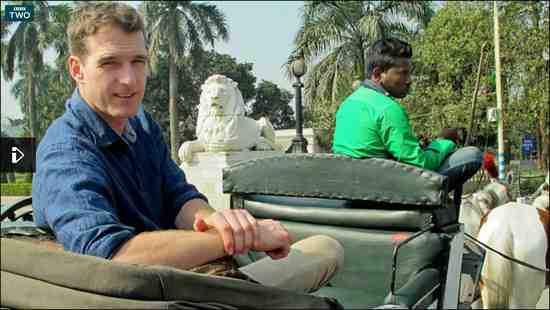The pomposity and extravagance of these White Mughals knew no bounds.
– BBC presenter Dan Snow in The Birth of Empire: The East India Company (Part 1)
 BBC Presenter Dan Snow in Calcutta
BBC Presenter Dan Snow in Calcutta
Indians must watch BBC’s new TV program The Birth of Empire: The East India Company if only to refresh fading memories of an inglorious and dark chapter in their history.
Just because some Chutiyas (Indians) now have enough clothes to cover their private parts, Indians delude themselves that they’ve arrived on the world stage!
Little do Indians grasp how tenuous their foothold is on the slow train to freedom and development.
Chutiyas must strive to understand their enslavement if they wish to avoid a repetition of past humiliation.
Presented by Dan Snow, Part One of The Birth of Empire: The East India Company is 60-minutes long.
Snow is a lively presenter and does a good job of showcasing how his forbears established an empire in India in the 17th century.
The program covers all the high-points of the East India Company – Its foundation, establishment of the trading outposts in Madras, Calcutta and elsewhere, Robert Clive’s victory at the Battle of Plassey, the company’s subsequent entrenchment and merciless exploitation of India and its people.
Birth of Empire is a two-part program. The first part aired last month on BBC Two and the second is due Wednesday, May 7, 2014.
Chutiyas Enslaved
Of the great tragedies in human history, few can match the enslavement of India and its people by the East India Company of England.
In what now seems like an astonishing miracle, a small trading company, from a country 14,000 miles away, whipped a nation of 140 million (in the 17th century) into abject submission.
Beneath the veneer of civilization, Men (and, by God, Women too) are predatory creatures who unhesitatingly swoop down on those they consider weaklings.
And if there’s one group that’s turned predation into a fine art, it’s White Men with their forked tongue, seemingly gracious manners, adventurous spirit and murderous resolve.
Braving disease, harsh elements, a long and arduous sea voyage and an uncertain outcome at the destination, the White Men of the East India Company came to India to trade.
But their appetite whetted by early riches, spurred by greed and abetted by powerful weapons, they stayed on to loot and pillage the land for over three centuries (including after formal control of India passed from the East India Company to the British government).
Timing is Everything
Call it timing, or call it luck.
When the East India Company entered India around 1639 and established their first trading post at Madraspatnam (now Chennai), the timing couldn’t have been better.
The Mughal empire was no longer at its zenith and after the death of Aurangzeb its writ no longer carried much weight in the far corners of the vast country.
By 1700, the East India Company had 22 trading posts across the country.
Through clever alliances with local satraps and by honing divide et impera into a powerful weapon, the East India Company became the state with its own army, taxing powers and civil administration in the 18th century.
Plowing Indian Women
Birth of Empire is not merely about plowing the terrain of politics and takeover of India by the East India Company for enrichment of its shareholders.
The TV program mentions that company employees were also busy playing in other domains.
With White women scarce in the country and priapic urges soaring under the scorching heat of the tropical sun, many employees of the East India Company started cohabiting with local women. Some had several Indian mistresses.
By 1850, 90% of East India Company employees were plowing the fertile fields of Indian women (and presumably scattering their seeds for the birth of what’s now referred to as Anglo-Indians).
The first episode also touches upon other issues like the Bengal famine that killed over 10 million, the social life of the employees, the killer heat, diseases like dysentery that killed many young employees of the company, the Black Hole of Kolkata and the huge fortunes made by people like Robert Clive who then went on to live like Nabobs.
Birth of Empire was filmed in Madras, Kolkata, London and elsewhere in India and England.
The photography is decent and Snow is a charming presenter.
The Birth of Empire (Part 1) is available on BBC Two via iPlayer until May 14, 2014.
Part 2 will air on BBC Two on May 7/8, 2014.

In school we get a very sanitised version of how these guys managed to take over the entire country.
The truth on how it happened and the details are missing.
They are shown as bad guys always but I think the reality is they saw the opportunity and exploited it.
Its possible that the actions of a lot of Indians who worked with them because they opposed their local raja or the mughals must have benefited them. They were able to exploit both the caste structure in India that repressed many Indians who probably did not care who their oppressor was and did not lift a finger to change it.
Also religious differences might have played a role too and being ruled by Idiot Rajas who are too busy trying to maintain their lifestyle. The story is still amazing.
What’s amazing is they were able to play this game in many countries in the world and conquer them.
SearchIndia.com Responded:
1. You write: They are shown as bad guys always but I think the reality is they saw the opportunity and exploited it.
Very true.
The British of that era (17th Century) were an enterprising, valorous and adventurous bunch.
The present lot are either poodles or into binge drinking and puking on the street. The epitome of White trash!
http://www.theguardian.com/responsibledrinking/teenagers
2. But for the outsourcing boom, millions of Indian men would still be parading around in their loin cloths and the women would be moving around bare-chested. Not an uncommon sight in India until a few decades back.
Not an uncommon sight in India until a few decades back.
Indians, for the most part, have lacked the gene for valor and adventure. They’re a pusillanimous race who get what they deserve!
History is made up by who write it. I hope in any case of a major event in history, there will be at least two versions.
For ex., Tamil Chola dynasty’s overseas invasion of Srivijaya (modern day Indonesia) / Kedaram (kedah) is still being celebrated for Cholas’ valour.
But the versions from writers elsewhere would consider that Cholas disrupted their harmony, and influenced their original culture.
http://en.wikipedia.org/wiki/Chola_invasion_of_Srivijaya
http://en.wikipedia.org/wiki/Srivijaya#Relationship_with_regional_powers
The links do say that – “Cholas have benefited from both Piracy and Invasion”.
And,
“According to the 15th century Malay annals Sejarah Melayu Rajendra Chola I, after the successful naval raid in 1025, seems to have married Onang Kiu the daughter of the defeated king”
SearchIndia.com Responds:
You write: I hope in any case of a major event in history, there will be at least two versions.
Sweetie, there are no two versions or three versions.
East India Company enslaved India and its people.
There are no other versions.
Subsequent comments by the British and others that they unified India, gave us English language, brought us civilization etc etc are merely post facto justifications of brutality and plunder.